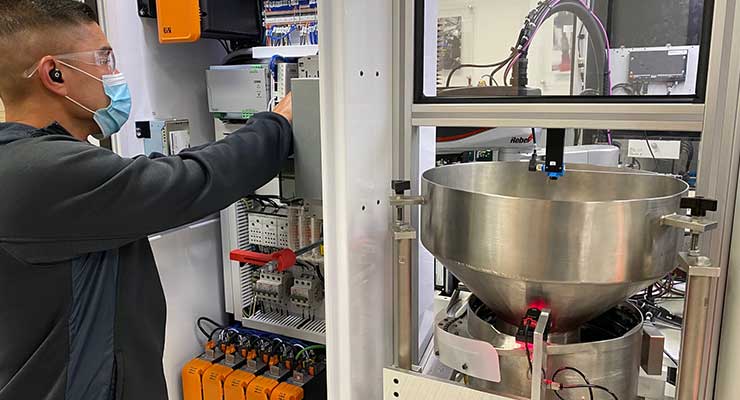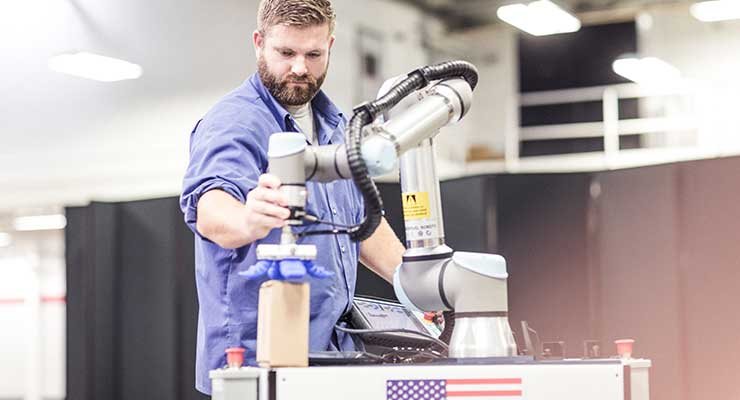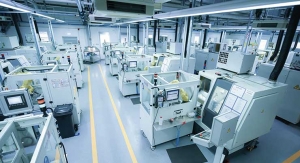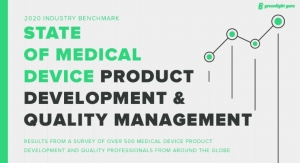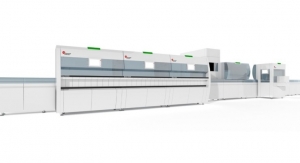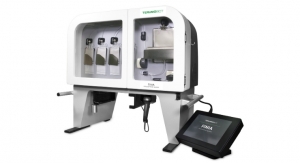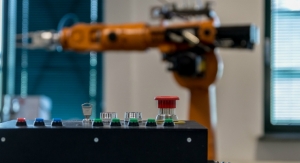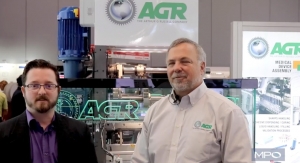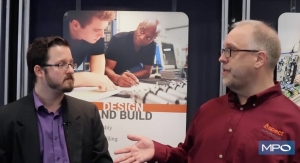Sam Brusco, Associate Editor09.01.20
Industry 4.0 and IoT technologies can help provide solutions for the growing assembly and automation demands from medical device manufacturers. Products are getting smaller and more complex—this miniaturization puts increased pressure on automation and component suppliers to make high-volume components at much tighter tolerances than they’re used to.
Industry 4.0 technologies help to integrate operations, parts, workstations, and other tasks seamlessly across the factory floor. Medical device OEMs rely on automation to maximize product quality through consistent part assembly, precise placement of smaller or high-precision medical products, and manufacturing speed for higher volumes. Sensors, big data, and predictive analytics also analyze machine performance and boost production, throughput, and maintenance.
To gain more insight on the trends and challenges affecting the assembly and automation industries, I spoke with several assembly and automation experts over the past few weeks:
John Budreau, director of new business development at PTI Engineered Plastics, a Macomb, Mich.-based injection molder and manufacturer of plastic components and assemblies.
Andrea Gizzi, project manager; David Klafehn, contract manufacturing manager; David Bierbrauer, automation manager; and Mari Foley, marketing manager at Röchling Medical, a Rochester, N.Y.-based manufacturer of customized medical components and assemblies, right through to end-to-end OEM products.
Maciej Lisiak, micro team manager at FUTEK Advanced Sensor Technology Inc., an Irvine, Calif.-based manufacturer of load cells, torque sensors, pressure sensors, multi-axis sensors, and related instruments and software.
Julie Logothetis, president of Kahle Automation, a Morristown, N.J.-based provider of high-speed automation and process equipment for the medical device, pharmaceutical, and healthcare industries.
Ryan Moran, global automation program manager at SMC Ltd., a Somerset, Wis.-based global contract manufacturer of pharmaceutical and finished medical devices.
Al Neumann, automated mfg. systems manager at SMC Ltd.
Kevin B. Smith, PE, senior director of advanced manufacturing technologies at Canon Virginia Inc., a Newport News, Va.-based contract manufacturer for the medical device industry.
Bill Welch, chief technology officer of Phillips-Medisize, a Molex company. Based in Hudson, Wis., Phillips-Medisize is a global outsource provider of design and manufacturing services serving the drug delivery, medical device, and primary pharmaceutical packaging markets.
Tim Witherow, senior manager of manufacturing assembly & automation at PTI Engineered Plastics.
Sam Brusco: What market forces are fueling the need for automation?
John Budreau: One of the primary forces that has always been a driving force and will continue to be is cost competitiveness. We also find another driver is part handling to protect aesthetic quality. We make regular use of automation within the injection molding machine cell to perform assembly or sub-assembly operations.
Maciej Lisiak: The main drivers are the need for high-volume scalability and process control. This originated in the Japanese automotive industry, which became a benchmark for streamlined manufacturing and quality assurance. The concept of automation was further elevated by the personal computer industry; now micro component level requirements are aggressively fueled by the miniaturization of mobile electronics. The medical device industry is pushing the envelope of automation even further.
Surgical robotics is re-shaping the definition of automation. This approach was built on the concept of remotely operated surgery in the front lines of military applications, which became the backbone of minimally intrusive robotic surgery as we know it today. Miniaturization of force, torque, and haptic feedback systems allowed for this latest evolution of smart medical tools, while also opening the door for big data analytics and future AI capabilities to be developed for the medical and automation industries. The surgical robotics revolution allows for faster patient recovery time and opens possibilities for more complex procedures, which are not possible to perform using conventional manual procedures.
Julie Logothetis: The COVID-19 pandemic has called for a huge increase in demand for basic medical devices. U.S. manufacturers who spent the last few decades thinking about ways to cut costs by purchasing the products from China and not investing in updates to their internal manufacturing infrastructure are now seeing upgrades to their manufacturing are going to be needed.
Röchling team: Cost reduction per part is a significant driver. Automation can improve quality and eliminate human error.
Ryan Moran: I believe this is multi-faceted, but largely leads back to the overall price required for full-scale commercialization of most products. The price pressure comes from various areas, such as ever-increasing wages/cost of living, increases in cost of purchased components, in some cases an incompressible amount of labor to manufacture at scale, etc. Understanding automation is typically not cheap and requires upfront capital. We routinely work with our customers to implement a phased-in approach for the automation. In most cases, starting with a more manual approach that can be validated and is scalable helps efforts to learn the product manufacturing processes required to properly and consistently produce acceptable devices. As the confidence in the product, processes, and market acceptance grow, so does the need for a more automated solution.
Al Neumann: With the current state of the world, medical OEMs want to bring back overseas products to U.S.-based manufacturing. The challenge then becomes how to match the cost of inexpensive labor through automation. Replacing manual operations with simple automation reduces labor costs while ensuring quality.
Kevin Smith: Quality and delivery are the primary drivers towards automation, with cost being a secondary aspect addressed once the initial drivers are met. COVID-19 is a great example of an automation driver. There is a global need not only for quick and accurate testing equipment, but also for millions of test kits. The only feasible way to manufacture millions per day is through automation.
Bill Welch: Several market forces are at play that fuel the need for automation in high-volume manufacturing. The primary drivers for automation are to reduce variation and improve quality—which also helps lower cost and labor. Another vital force is the need to reduce supply chains for high-volume products. A strong approach to automation provides the ability to “copy-paste” the same tooling and automation systems for use in multiple geographies, to minimize variation. Primarily, customers across the globe can benefit the same quality—but production within the customers’ regions reduces supply chain risk.
Brusco: What are the latest innovations in medtech assembly and automation technology/services?
Lisiak: We are at the tipping point stage of the evolution of medtech with solutions that took over two decades to develop. Now that we have the micro miniaturization of sensors in place, the sensing capability is literally being pushed to the tip of surgical tools. This allows for more precise process control and real-time, fully active haptic feedback.
As this now proven technology is flowing into the medical marketplace, cost per-procedure is becoming a critical factor, to be expected from highly complex robotic devices. This area needs to be addressed with electronics components and sensors able to survive harsh sterilization environments.
The medical industry pushes the technology forward by requiring more advanced environmental protection capabilities. To put this in perspective, look at consumer electronics. Some of the most advanced mobile devices are IP67 submersion rated, meaning they are capable of surviving one meter of water submersion for one hour. Compare this with medical application requirements, where a device needs to survive submersion in boiling water. In fact, this requirement is often as strict as hundreds of cycles in 137oC saturated steam and high pH autowash, which kills conventional electronics at point of contact.
(NOTE: we don’t recommend boiling your smartphone, at least back up your data and say goodbye at your own risk.)
Neumann: Most of the innovation has been in flexible automation as a whole and to a lesser extent the use of augmented reality as well as mechanical and control simulation in the upfront design approval process.
We rely on a control system that can handle a multitude of tasks. One of our builds uses a single controller to supervise the motion of 12 different servos, an RFID-tag reader/writer, OCR vision system, and over 80 sensors. We were able to reduce validation costs, simplify programming, reduce assembly build time, and reduce component costs. Many of the “modules” our programmers wrote can be used in other applications, further reducing build times.
Röchling team: Collaborative robots are one of the latest innovations in medtech assembly. The robot and operator work in the same workspace, while sensors help to detect and guide the robot to avoid the operator’s movements. There has also been a significant improvement to vision system capabilities, where higher pixel cameras help ensure quality and output detecting within .002”. In addition, measurement improvements have been enhanced by laser micrometers which can more precisely measure dimensions in real-time.
Welch: Two key innovations come to mind. First, there is a continued evolution and advancement of modular assembly platforms, which reduces time, cost, and validation complexity. Global automation leaders have developed and brought to market core platforms, with strong adoption. Second, we see ongoing development and deployment of low-cost, flexible solutions (i.e., cobots) that work well for multiple products and alongside humans safely. This development is a significant breakthrough, given the flexibility and ease of deployment vs. using human labor or complex, custom automation that poses high cost, space, and validation barriers.
Tim Witherow: We are taking advantage of modular automation in order to maximize per project investment and still benefit on repeatability, efficiency, and overall cost. We are in the process of utilizing collaborative robots to reduce costs and maximize our ability to do repetitive tasks.
Brusco: How are smaller, more complex medical devices/components challenging assembly and automation technologies/services?
Lisiak: Miniaturization is forcing industries to reshape manufacturing processes. This transformation can be compared to the fundamentals of dynamics vs. quantum physics, where completely new laws start to apply. As miniaturization puts most manual processes out of the equation, we have to re-invent fabrication, handling, assembly, and quality control processes.
Based on rapidly growing market demands, highly complex miniaturized devices require volume streamlining through batch manufacturing to assure high scalability. On the other hand, miniaturized force and torque sensors are opening the door for micro-level automation, force feedback control with high natural frequency, and low power consumption capabilities.
Medtech applications need to have extremely high reliability. One aspect is redundancy, which can be incorporated on haptic feedback sensors, both in the mechanical mounting and as electronic circuitry components. These can be additionally supported with third level fault detection for short, or open circuit failure.
Such highly complex miniaturized feedback systems assure that in the event of a component failure, a critical surgical procedure can be completed without any interaction and provide real-time data triggering a preventive maintenance schedule.
Overload capability also plays a very important role for the reliability of any mechanical medtech application. From a design standpoint, overload capability becomes even more challenging when you’re dealing with highly miniaturized mechanical sensing assemblies. FUTEK has pioneered the mechanical overload stop by creating sensors that can withstand up to 1,000 percent overload condition without failure.
Logothetis: The newer drug delivery options coming to the market are extremely complex in design to manufacture and require complex and costly automation solutions. Most of the designs consist of multiple micro components with critical specifications and assembly constraints. The failure of these devices to perform in the field is not option, so in addition to the assembly, the automation must perform critical quality and testing requirements.
Moran: I wouldn’t necessarily say the challenge comes from the size and complexity, more so in fully understanding the requirements and expectations of the automation upfront. With a proper understanding of the requirements, one can best select their automation partner, ideally at the beginning of the project. If the expectation of the device is ever to automate, it is in everyone’s best interest to start those conversations as far upstream as possible to increase your odds of a proper launch. It’s important to know what’s needed to choose the proper partner, whether it’s an understanding for tight tolerances, attention to detail, ability to create proof of principle(s), assist with Design for Manufacturing, ability to ramp to high volume production (assembly, test, packaging, etc.), having access to a test lab, etc.
Neumann: The challenge of handling small components and putting together complex assemblies can be decreased through early involvement. Thinking about “designing for automation,” a member of our Automated Mfg. Systems group is often a valuable part of early project engagement. Many times a small change in design, a shade different color, or a bit of applied texture can simplify an otherwise difficult detection or assembly task.
Röchling team: When parts are small or have intricate features, the ability to grip and hold with automated equipment becomes difficult. The feeding of parts is also challenging due to the fragility of the pieces. Overall, part management is more complicated the smaller the parts are.
Smith: End of Arm Tooling (EOAT) is the primary challenge as assemblies become smaller and increase in complexity. Intricately intermingling more and more components in an ever-decreasing work envelope continually challenge our assembly approach and EOAT engineering.
Welch: We have developed a micro-assembly—roughly the size of a grain of rice—that contains two plastic, two silicone, and one additional purchased component. The challenges are many, and they span from the molding of components, handling individual components, microdispensing of adhesive, and finally, assembly and inspection. The advancements in micro-assembly and inspection (driven by precision tooling and higher capability cameras) make possible today what could not be done at the same quality levels 10 years ago.
Witherow: Manufacturing smaller parts is a challenge. It is a different mindset when starting out a design for automation. Each process must require minimal variation to produce a repeatable assembly.
Brusco: What assembly in medtech manufacturing is still done by hand, and how might it become automated?
Budreau: Justification for automation is largely driven by project volume or part-specific needs. Many fasteners, thermal inserts, gluing operations, and welding processes are still done by hand.
Lisiak: The industry is in rapid growth transition mode and steadily shifting toward full automation, which is continuously being pushed by constantly evolving medical device miniaturization requirements. On the other hand, force and torque sensor miniaturization is allowing for improved process control through either smart tool semi-automation, or full-automation approach.
Logothetis: Most recently Kahle has seen a trend where we have been asked to replace the manual assembly of IV tubing sets. They have traditionally been manually manufactured off shore. In the past, these machines have been considered too expensive and the components too cumbersome to handle; however, with the savings in labor, a single machine can replace hundreds of people. The added bonus of better quality and consistency of the assembly has also motivated manufactures to automate these processes.
Moran: Somewhat of a loaded question, but ultimately anything in development, lower volume manufacturing, and great deal of tube set assemblies with multiple configurations. Flexible automation and cobots coupled with the right applications can certainly help with the “lower volume” applications.
Röchling team: When working with products with an electrical component, wire management may best be handled manually rather than with automation. The length and width of the wire may be difficult to manipulate due to the wire’s properties. Curling or flexing can cause issues where equipment cannot hold the proper placement. Flexible tubing can also pose issues for automated machinery, therefore it may be best to handle manually.
Brusco: Is there such a thing as “too much automation” in medtech manufacturing? If so, why? If not, why not?
Lisiak: Manual process means limited scalability and dependence on operator performance. The high reliability and volume requirements driven by the medtech industry pretty much defaults us to an automated manufacturing approach. In the case of medical applications, where sterilization is a critical aspect of the manufacturing process itself, automated solutions provide an additional advantage with lower contamination risks. Automation also makes manufacturing less vulnerable to situations like the pandemic impact.
Logothetis: I don’t believe there can ever be too much automation in medtech manufacturing, but I do believe caution should be taken when considering automation. Smart solutions should be applied that include minimal handling of components and studying the process flow to keep components clean and processes efficient.
Moran: There certainly is, everything in moderation. If not designed, built, managed, validated, and implemented correctly the automation can be as much a hindrance to the efficiency of the manufacturing process(es) as it can be a savior. It’s not ideal to automate products and/or processes that are underdeveloped, not designed to be scalable, or don’t necessarily need the throughput.
Neumann: If volumes are significant and user requirements warrant a high level of inspection, automation may be mandatory! However, advancing the technology in our workcells may out-pace the ability for a facility to maintain and troubleshoot that equipment. We’ve spent a great deal of time developing diagnostic screens that help equipment “troubleshoot itself,” showing a technician where the fault is most likely situated. We also equip our workcells with VPN gateways that allow Automated Mfg. Systems engineers to remotely monitor a machine’s controller to quickly detect a problem.
Röchling team: In certain circumstances such as low volume runs, the cost of automation may be too high to justify. Other circumstances could include when there are many product components needing assembly, or moving parts with multiple destinations. In other circumstances, temperatures or pressures may need to be held while waiting for additional parts of the assembly to finish. Automation may struggle to accomplish both tasks in tandem. The design complexity of the product or part orientation may also not lend itself to automation easily.
Smith: Automation is the heart of precision assembly and detailed inspection, which results in a higher quality and more reliable product. How can we have too much automation in the medtech world based on these strengths?
Welch: Yes, there is. The automation needs to fit the scale. High-speed, high-volume automation has expensive start-up and maintenance costs, as well as high requirements for validation, floor space, and other resources. Costs can go up, while predictability of delivery goes down. There’s no quality advantage vs. having a well-constructed semi-auto or low-volume full-auto solution.
Witherow: It depends on annual volume and ROI on your automation/capital. Ultra-low volume devices or products would have minimal automation unless it was a part specific requirement to automate. In certain cases, there is such a thing as too much automation. The point is to reduce labor or increase quality—hopefully, both. With too much automation, you end up adding engineering or technician labor to keep the automation going. It has to be simple and cost-effective.
Brusco: What do you anticipate to become possible for medtech assembly and automation technology in the next few years?
Lisiak: The next evolution of surgical robotics/medical process automation is expected to be driven by big data analytics supporting artificial intelligence algorithms that are based on real-time vision, motion, and force/torque feedback data streaming. If you consider it takes decades of experience for surgeons to be able to perform some of the most complex surgeries, and imagine reversing that process by building an instant experience based on a database of millions of surgeries performed by a robotic system, you get a sense of the possibilities that lie ahead. But in order for that to be possible, you will need high reliability force and torque embedded measurement to support clean data acquisition to get meaningful results.
Moran: I think it will be possible to better integrate the assembly and packaging lines to inventory management and warehousing by using mobile industrial robots with automated warehousing management software.
Röchling team: Vision-guided robots will become better in the future. Measurement tolerances will become tighter, as customers are demanding higher precision for their products. Costs over time for robots will decrease due to the demand needed in the market. Robots will also become more flexible, imitating human movements of picking up parts and manipulating them.
Smith: Hardware, sensors, and vision options are becoming smaller, smarter, more precise, and less expensive all the time. These improved building blocks, combined with evolving software and open source AI, will allow advances in self-corrected automation to assemble medtech products at higher quality levels than ever imagined possible.
Welch: We anticipate modular assembly platforms will continue to drive down cost and validation barriers to automation. In contrast, advancements in machine vision, AI, and the software will create systems that are more intuitive and less prone to errors or quality escapes.
Witherow: The automation industry has made great improvements recently in two major areas. First being accuracy of robotics and secondly the ease of programming. If we continue these trends, we will see more automation at lower volumes. We will also see basic programming done by technicians and team leaders instead of only engineers.
Industry 4.0 technologies help to integrate operations, parts, workstations, and other tasks seamlessly across the factory floor. Medical device OEMs rely on automation to maximize product quality through consistent part assembly, precise placement of smaller or high-precision medical products, and manufacturing speed for higher volumes. Sensors, big data, and predictive analytics also analyze machine performance and boost production, throughput, and maintenance.
To gain more insight on the trends and challenges affecting the assembly and automation industries, I spoke with several assembly and automation experts over the past few weeks:
John Budreau, director of new business development at PTI Engineered Plastics, a Macomb, Mich.-based injection molder and manufacturer of plastic components and assemblies.
Andrea Gizzi, project manager; David Klafehn, contract manufacturing manager; David Bierbrauer, automation manager; and Mari Foley, marketing manager at Röchling Medical, a Rochester, N.Y.-based manufacturer of customized medical components and assemblies, right through to end-to-end OEM products.
Maciej Lisiak, micro team manager at FUTEK Advanced Sensor Technology Inc., an Irvine, Calif.-based manufacturer of load cells, torque sensors, pressure sensors, multi-axis sensors, and related instruments and software.
Julie Logothetis, president of Kahle Automation, a Morristown, N.J.-based provider of high-speed automation and process equipment for the medical device, pharmaceutical, and healthcare industries.
Ryan Moran, global automation program manager at SMC Ltd., a Somerset, Wis.-based global contract manufacturer of pharmaceutical and finished medical devices.
Al Neumann, automated mfg. systems manager at SMC Ltd.
Kevin B. Smith, PE, senior director of advanced manufacturing technologies at Canon Virginia Inc., a Newport News, Va.-based contract manufacturer for the medical device industry.
Bill Welch, chief technology officer of Phillips-Medisize, a Molex company. Based in Hudson, Wis., Phillips-Medisize is a global outsource provider of design and manufacturing services serving the drug delivery, medical device, and primary pharmaceutical packaging markets.
Tim Witherow, senior manager of manufacturing assembly & automation at PTI Engineered Plastics.
Sam Brusco: What market forces are fueling the need for automation?
John Budreau: One of the primary forces that has always been a driving force and will continue to be is cost competitiveness. We also find another driver is part handling to protect aesthetic quality. We make regular use of automation within the injection molding machine cell to perform assembly or sub-assembly operations.
Maciej Lisiak: The main drivers are the need for high-volume scalability and process control. This originated in the Japanese automotive industry, which became a benchmark for streamlined manufacturing and quality assurance. The concept of automation was further elevated by the personal computer industry; now micro component level requirements are aggressively fueled by the miniaturization of mobile electronics. The medical device industry is pushing the envelope of automation even further.
Surgical robotics is re-shaping the definition of automation. This approach was built on the concept of remotely operated surgery in the front lines of military applications, which became the backbone of minimally intrusive robotic surgery as we know it today. Miniaturization of force, torque, and haptic feedback systems allowed for this latest evolution of smart medical tools, while also opening the door for big data analytics and future AI capabilities to be developed for the medical and automation industries. The surgical robotics revolution allows for faster patient recovery time and opens possibilities for more complex procedures, which are not possible to perform using conventional manual procedures.
Julie Logothetis: The COVID-19 pandemic has called for a huge increase in demand for basic medical devices. U.S. manufacturers who spent the last few decades thinking about ways to cut costs by purchasing the products from China and not investing in updates to their internal manufacturing infrastructure are now seeing upgrades to their manufacturing are going to be needed.
Röchling team: Cost reduction per part is a significant driver. Automation can improve quality and eliminate human error.
Ryan Moran: I believe this is multi-faceted, but largely leads back to the overall price required for full-scale commercialization of most products. The price pressure comes from various areas, such as ever-increasing wages/cost of living, increases in cost of purchased components, in some cases an incompressible amount of labor to manufacture at scale, etc. Understanding automation is typically not cheap and requires upfront capital. We routinely work with our customers to implement a phased-in approach for the automation. In most cases, starting with a more manual approach that can be validated and is scalable helps efforts to learn the product manufacturing processes required to properly and consistently produce acceptable devices. As the confidence in the product, processes, and market acceptance grow, so does the need for a more automated solution.
Al Neumann: With the current state of the world, medical OEMs want to bring back overseas products to U.S.-based manufacturing. The challenge then becomes how to match the cost of inexpensive labor through automation. Replacing manual operations with simple automation reduces labor costs while ensuring quality.
Kevin Smith: Quality and delivery are the primary drivers towards automation, with cost being a secondary aspect addressed once the initial drivers are met. COVID-19 is a great example of an automation driver. There is a global need not only for quick and accurate testing equipment, but also for millions of test kits. The only feasible way to manufacture millions per day is through automation.
Bill Welch: Several market forces are at play that fuel the need for automation in high-volume manufacturing. The primary drivers for automation are to reduce variation and improve quality—which also helps lower cost and labor. Another vital force is the need to reduce supply chains for high-volume products. A strong approach to automation provides the ability to “copy-paste” the same tooling and automation systems for use in multiple geographies, to minimize variation. Primarily, customers across the globe can benefit the same quality—but production within the customers’ regions reduces supply chain risk.
Brusco: What are the latest innovations in medtech assembly and automation technology/services?
Lisiak: We are at the tipping point stage of the evolution of medtech with solutions that took over two decades to develop. Now that we have the micro miniaturization of sensors in place, the sensing capability is literally being pushed to the tip of surgical tools. This allows for more precise process control and real-time, fully active haptic feedback.
As this now proven technology is flowing into the medical marketplace, cost per-procedure is becoming a critical factor, to be expected from highly complex robotic devices. This area needs to be addressed with electronics components and sensors able to survive harsh sterilization environments.
The medical industry pushes the technology forward by requiring more advanced environmental protection capabilities. To put this in perspective, look at consumer electronics. Some of the most advanced mobile devices are IP67 submersion rated, meaning they are capable of surviving one meter of water submersion for one hour. Compare this with medical application requirements, where a device needs to survive submersion in boiling water. In fact, this requirement is often as strict as hundreds of cycles in 137oC saturated steam and high pH autowash, which kills conventional electronics at point of contact.
(NOTE: we don’t recommend boiling your smartphone, at least back up your data and say goodbye at your own risk.)
Neumann: Most of the innovation has been in flexible automation as a whole and to a lesser extent the use of augmented reality as well as mechanical and control simulation in the upfront design approval process.
We rely on a control system that can handle a multitude of tasks. One of our builds uses a single controller to supervise the motion of 12 different servos, an RFID-tag reader/writer, OCR vision system, and over 80 sensors. We were able to reduce validation costs, simplify programming, reduce assembly build time, and reduce component costs. Many of the “modules” our programmers wrote can be used in other applications, further reducing build times.
Röchling team: Collaborative robots are one of the latest innovations in medtech assembly. The robot and operator work in the same workspace, while sensors help to detect and guide the robot to avoid the operator’s movements. There has also been a significant improvement to vision system capabilities, where higher pixel cameras help ensure quality and output detecting within .002”. In addition, measurement improvements have been enhanced by laser micrometers which can more precisely measure dimensions in real-time.
Welch: Two key innovations come to mind. First, there is a continued evolution and advancement of modular assembly platforms, which reduces time, cost, and validation complexity. Global automation leaders have developed and brought to market core platforms, with strong adoption. Second, we see ongoing development and deployment of low-cost, flexible solutions (i.e., cobots) that work well for multiple products and alongside humans safely. This development is a significant breakthrough, given the flexibility and ease of deployment vs. using human labor or complex, custom automation that poses high cost, space, and validation barriers.
Tim Witherow: We are taking advantage of modular automation in order to maximize per project investment and still benefit on repeatability, efficiency, and overall cost. We are in the process of utilizing collaborative robots to reduce costs and maximize our ability to do repetitive tasks.
Brusco: How are smaller, more complex medical devices/components challenging assembly and automation technologies/services?
Lisiak: Miniaturization is forcing industries to reshape manufacturing processes. This transformation can be compared to the fundamentals of dynamics vs. quantum physics, where completely new laws start to apply. As miniaturization puts most manual processes out of the equation, we have to re-invent fabrication, handling, assembly, and quality control processes.
Based on rapidly growing market demands, highly complex miniaturized devices require volume streamlining through batch manufacturing to assure high scalability. On the other hand, miniaturized force and torque sensors are opening the door for micro-level automation, force feedback control with high natural frequency, and low power consumption capabilities.
Medtech applications need to have extremely high reliability. One aspect is redundancy, which can be incorporated on haptic feedback sensors, both in the mechanical mounting and as electronic circuitry components. These can be additionally supported with third level fault detection for short, or open circuit failure.
Such highly complex miniaturized feedback systems assure that in the event of a component failure, a critical surgical procedure can be completed without any interaction and provide real-time data triggering a preventive maintenance schedule.
Overload capability also plays a very important role for the reliability of any mechanical medtech application. From a design standpoint, overload capability becomes even more challenging when you’re dealing with highly miniaturized mechanical sensing assemblies. FUTEK has pioneered the mechanical overload stop by creating sensors that can withstand up to 1,000 percent overload condition without failure.
Logothetis: The newer drug delivery options coming to the market are extremely complex in design to manufacture and require complex and costly automation solutions. Most of the designs consist of multiple micro components with critical specifications and assembly constraints. The failure of these devices to perform in the field is not option, so in addition to the assembly, the automation must perform critical quality and testing requirements.
Moran: I wouldn’t necessarily say the challenge comes from the size and complexity, more so in fully understanding the requirements and expectations of the automation upfront. With a proper understanding of the requirements, one can best select their automation partner, ideally at the beginning of the project. If the expectation of the device is ever to automate, it is in everyone’s best interest to start those conversations as far upstream as possible to increase your odds of a proper launch. It’s important to know what’s needed to choose the proper partner, whether it’s an understanding for tight tolerances, attention to detail, ability to create proof of principle(s), assist with Design for Manufacturing, ability to ramp to high volume production (assembly, test, packaging, etc.), having access to a test lab, etc.
Neumann: The challenge of handling small components and putting together complex assemblies can be decreased through early involvement. Thinking about “designing for automation,” a member of our Automated Mfg. Systems group is often a valuable part of early project engagement. Many times a small change in design, a shade different color, or a bit of applied texture can simplify an otherwise difficult detection or assembly task.
Röchling team: When parts are small or have intricate features, the ability to grip and hold with automated equipment becomes difficult. The feeding of parts is also challenging due to the fragility of the pieces. Overall, part management is more complicated the smaller the parts are.
Smith: End of Arm Tooling (EOAT) is the primary challenge as assemblies become smaller and increase in complexity. Intricately intermingling more and more components in an ever-decreasing work envelope continually challenge our assembly approach and EOAT engineering.
Welch: We have developed a micro-assembly—roughly the size of a grain of rice—that contains two plastic, two silicone, and one additional purchased component. The challenges are many, and they span from the molding of components, handling individual components, microdispensing of adhesive, and finally, assembly and inspection. The advancements in micro-assembly and inspection (driven by precision tooling and higher capability cameras) make possible today what could not be done at the same quality levels 10 years ago.
Witherow: Manufacturing smaller parts is a challenge. It is a different mindset when starting out a design for automation. Each process must require minimal variation to produce a repeatable assembly.
Brusco: What assembly in medtech manufacturing is still done by hand, and how might it become automated?
Budreau: Justification for automation is largely driven by project volume or part-specific needs. Many fasteners, thermal inserts, gluing operations, and welding processes are still done by hand.
Lisiak: The industry is in rapid growth transition mode and steadily shifting toward full automation, which is continuously being pushed by constantly evolving medical device miniaturization requirements. On the other hand, force and torque sensor miniaturization is allowing for improved process control through either smart tool semi-automation, or full-automation approach.
Logothetis: Most recently Kahle has seen a trend where we have been asked to replace the manual assembly of IV tubing sets. They have traditionally been manually manufactured off shore. In the past, these machines have been considered too expensive and the components too cumbersome to handle; however, with the savings in labor, a single machine can replace hundreds of people. The added bonus of better quality and consistency of the assembly has also motivated manufactures to automate these processes.
Moran: Somewhat of a loaded question, but ultimately anything in development, lower volume manufacturing, and great deal of tube set assemblies with multiple configurations. Flexible automation and cobots coupled with the right applications can certainly help with the “lower volume” applications.
Röchling team: When working with products with an electrical component, wire management may best be handled manually rather than with automation. The length and width of the wire may be difficult to manipulate due to the wire’s properties. Curling or flexing can cause issues where equipment cannot hold the proper placement. Flexible tubing can also pose issues for automated machinery, therefore it may be best to handle manually.
Brusco: Is there such a thing as “too much automation” in medtech manufacturing? If so, why? If not, why not?
Lisiak: Manual process means limited scalability and dependence on operator performance. The high reliability and volume requirements driven by the medtech industry pretty much defaults us to an automated manufacturing approach. In the case of medical applications, where sterilization is a critical aspect of the manufacturing process itself, automated solutions provide an additional advantage with lower contamination risks. Automation also makes manufacturing less vulnerable to situations like the pandemic impact.
Logothetis: I don’t believe there can ever be too much automation in medtech manufacturing, but I do believe caution should be taken when considering automation. Smart solutions should be applied that include minimal handling of components and studying the process flow to keep components clean and processes efficient.
Moran: There certainly is, everything in moderation. If not designed, built, managed, validated, and implemented correctly the automation can be as much a hindrance to the efficiency of the manufacturing process(es) as it can be a savior. It’s not ideal to automate products and/or processes that are underdeveloped, not designed to be scalable, or don’t necessarily need the throughput.
Neumann: If volumes are significant and user requirements warrant a high level of inspection, automation may be mandatory! However, advancing the technology in our workcells may out-pace the ability for a facility to maintain and troubleshoot that equipment. We’ve spent a great deal of time developing diagnostic screens that help equipment “troubleshoot itself,” showing a technician where the fault is most likely situated. We also equip our workcells with VPN gateways that allow Automated Mfg. Systems engineers to remotely monitor a machine’s controller to quickly detect a problem.
Röchling team: In certain circumstances such as low volume runs, the cost of automation may be too high to justify. Other circumstances could include when there are many product components needing assembly, or moving parts with multiple destinations. In other circumstances, temperatures or pressures may need to be held while waiting for additional parts of the assembly to finish. Automation may struggle to accomplish both tasks in tandem. The design complexity of the product or part orientation may also not lend itself to automation easily.
Smith: Automation is the heart of precision assembly and detailed inspection, which results in a higher quality and more reliable product. How can we have too much automation in the medtech world based on these strengths?
Welch: Yes, there is. The automation needs to fit the scale. High-speed, high-volume automation has expensive start-up and maintenance costs, as well as high requirements for validation, floor space, and other resources. Costs can go up, while predictability of delivery goes down. There’s no quality advantage vs. having a well-constructed semi-auto or low-volume full-auto solution.
Witherow: It depends on annual volume and ROI on your automation/capital. Ultra-low volume devices or products would have minimal automation unless it was a part specific requirement to automate. In certain cases, there is such a thing as too much automation. The point is to reduce labor or increase quality—hopefully, both. With too much automation, you end up adding engineering or technician labor to keep the automation going. It has to be simple and cost-effective.
Brusco: What do you anticipate to become possible for medtech assembly and automation technology in the next few years?
Lisiak: The next evolution of surgical robotics/medical process automation is expected to be driven by big data analytics supporting artificial intelligence algorithms that are based on real-time vision, motion, and force/torque feedback data streaming. If you consider it takes decades of experience for surgeons to be able to perform some of the most complex surgeries, and imagine reversing that process by building an instant experience based on a database of millions of surgeries performed by a robotic system, you get a sense of the possibilities that lie ahead. But in order for that to be possible, you will need high reliability force and torque embedded measurement to support clean data acquisition to get meaningful results.
Moran: I think it will be possible to better integrate the assembly and packaging lines to inventory management and warehousing by using mobile industrial robots with automated warehousing management software.
Röchling team: Vision-guided robots will become better in the future. Measurement tolerances will become tighter, as customers are demanding higher precision for their products. Costs over time for robots will decrease due to the demand needed in the market. Robots will also become more flexible, imitating human movements of picking up parts and manipulating them.
Smith: Hardware, sensors, and vision options are becoming smaller, smarter, more precise, and less expensive all the time. These improved building blocks, combined with evolving software and open source AI, will allow advances in self-corrected automation to assemble medtech products at higher quality levels than ever imagined possible.
Welch: We anticipate modular assembly platforms will continue to drive down cost and validation barriers to automation. In contrast, advancements in machine vision, AI, and the software will create systems that are more intuitive and less prone to errors or quality escapes.
Witherow: The automation industry has made great improvements recently in two major areas. First being accuracy of robotics and secondly the ease of programming. If we continue these trends, we will see more automation at lower volumes. We will also see basic programming done by technicians and team leaders instead of only engineers.

